Sebastian Schuster
Shammie
Code Pretraining Improves Entity Tracking Abilities of Language Models
May 31, 2024Abstract:Recent work has provided indirect evidence that pretraining language models on code improves the ability of models to track state changes of discourse entities expressed in natural language. In this work, we systematically test this claim by comparing pairs of language models on their entity tracking performance. Critically, the pairs consist of base models and models trained on top of these base models with additional code data. We extend this analysis to additionally examine the effect of math training, another highly structured data type, and alignment tuning, an important step for enhancing the usability of models. We find clear evidence that models additionally trained on large amounts of code outperform the base models. On the other hand, we find no consistent benefit of additional math training or alignment tuning across various model families.
Scope Ambiguities in Large Language Models
Apr 05, 2024Abstract:Sentences containing multiple semantic operators with overlapping scope often create ambiguities in interpretation, known as scope ambiguities. These ambiguities offer rich insights into the interaction between semantic structure and world knowledge in language processing. Despite this, there has been little research into how modern large language models treat them. In this paper, we investigate how different versions of certain autoregressive language models -- GPT-2, GPT-3/3.5, Llama 2 and GPT-4 -- treat scope ambiguous sentences, and compare this with human judgments. We introduce novel datasets that contain a joint total of almost 1,000 unique scope-ambiguous sentences, containing interactions between a range of semantic operators, and annotated for human judgments. Using these datasets, we find evidence that several models (i) are sensitive to the meaning ambiguity in these sentences, in a way that patterns well with human judgments, and (ii) can successfully identify human-preferred readings at a high level of accuracy (over 90% in some cases).
Entity Tracking in Language Models
May 03, 2023



Abstract:Keeping track of how states and relations of entities change as a text or dialog unfolds is a key prerequisite to discourse understanding. Despite this fact, there have been few systematic investigations into the ability of large language models (LLMs) to track discourse entities. In this work, we present a task to probe to what extent a language model can infer the final state of an entity given an English description of the initial state and a series of state-changing operations. We use this task to first investigate whether Flan-T5, GPT-3 and GPT-3.5 can track the state of entities, and find that only GPT-3.5 models, which have been pretrained on large amounts of code, exhibit this ability. We then investigate whether smaller models pretrained primarily on text can learn to track entities, through finetuning T5 on several training/evaluation splits. While performance degrades for more complex splits, we find that even for splits with almost no lexical overlap between training and evaluation, a finetuned model can often perform non-trivial entity tracking. Taken together, these results suggest that language models can learn to track entities but pretraining on large text corpora alone does not make this capacity surface.
Expectations over Unspoken Alternatives Predict Pragmatic Inferences
Apr 07, 2023Abstract:Scalar inferences (SI) are a signature example of how humans interpret language based on unspoken alternatives. While empirical studies have demonstrated that human SI rates are highly variable -- both within instances of a single scale, and across different scales -- there have been few proposals that quantitatively explain both cross- and within-scale variation. Furthermore, while it is generally assumed that SIs arise through reasoning about unspoken alternatives, it remains debated whether humans reason about alternatives as linguistic forms, or at the level of concepts. Here, we test a shared mechanism explaining SI rates within and across scales: context-driven expectations about the unspoken alternatives. Using neural language models to approximate human predictive distributions, we find that SI rates are captured by the expectedness of the strong scalemate as an alternative. Crucially, however, expectedness robustly predicts cross-scale variation only under a meaning-based view of alternatives. Our results suggest that pragmatic inferences arise from context-driven expectations over alternatives, and these expectations operate at the level of concepts.
Beyond the Imitation Game: Quantifying and extrapolating the capabilities of language models
Jun 10, 2022Abstract:Language models demonstrate both quantitative improvement and new qualitative capabilities with increasing scale. Despite their potentially transformative impact, these new capabilities are as yet poorly characterized. In order to inform future research, prepare for disruptive new model capabilities, and ameliorate socially harmful effects, it is vital that we understand the present and near-future capabilities and limitations of language models. To address this challenge, we introduce the Beyond the Imitation Game benchmark (BIG-bench). BIG-bench currently consists of 204 tasks, contributed by 442 authors across 132 institutions. Task topics are diverse, drawing problems from linguistics, childhood development, math, common-sense reasoning, biology, physics, social bias, software development, and beyond. BIG-bench focuses on tasks that are believed to be beyond the capabilities of current language models. We evaluate the behavior of OpenAI's GPT models, Google-internal dense transformer architectures, and Switch-style sparse transformers on BIG-bench, across model sizes spanning millions to hundreds of billions of parameters. In addition, a team of human expert raters performed all tasks in order to provide a strong baseline. Findings include: model performance and calibration both improve with scale, but are poor in absolute terms (and when compared with rater performance); performance is remarkably similar across model classes, though with benefits from sparsity; tasks that improve gradually and predictably commonly involve a large knowledge or memorization component, whereas tasks that exhibit "breakthrough" behavior at a critical scale often involve multiple steps or components, or brittle metrics; social bias typically increases with scale in settings with ambiguous context, but this can be improved with prompting.
When a sentence does not introduce a discourse entity, Transformer-based models still sometimes refer to it
May 06, 2022



Abstract:Understanding longer narratives or participating in conversations requires tracking of discourse entities that have been mentioned. Indefinite noun phrases (NPs), such as 'a dog', frequently introduce discourse entities but this behavior is modulated by sentential operators such as negation. For example, 'a dog' in 'Arthur doesn't own a dog' does not introduce a discourse entity due to the presence of negation. In this work, we adapt the psycholinguistic assessment of language models paradigm to higher-level linguistic phenomena and introduce an English evaluation suite that targets the knowledge of the interactions between sentential operators and indefinite NPs. We use this evaluation suite for a fine-grained investigation of the entity tracking abilities of the Transformer-based models GPT-2 and GPT-3. We find that while the models are to a certain extent sensitive to the interactions we investigate, they are all challenged by the presence of multiple NPs and their behavior is not systematic, which suggests that even models at the scale of GPT-3 do not fully acquire basic entity tracking abilities.
Coloring the Blank Slate: Pre-training Imparts a Hierarchical Inductive Bias to Sequence-to-sequence Models
Mar 17, 2022



Abstract:Relations between words are governed by hierarchical structure rather than linear ordering. Sequence-to-sequence (seq2seq) models, despite their success in downstream NLP applications, often fail to generalize in a hierarchy-sensitive manner when performing syntactic transformations - for example, transforming declarative sentences into questions. However, syntactic evaluations of seq2seq models have only observed models that were not pre-trained on natural language data before being trained to perform syntactic transformations, in spite of the fact that pre-training has been found to induce hierarchical linguistic generalizations in language models; in other words, the syntactic capabilities of seq2seq models may have been greatly understated. We address this gap using the pre-trained seq2seq models T5 and BART, as well as their multilingual variants mT5 and mBART. We evaluate whether they generalize hierarchically on two transformations in two languages: question formation and passivization in English and German. We find that pre-trained seq2seq models generalize hierarchically when performing syntactic transformations, whereas models trained from scratch on syntactic transformations do not. This result presents evidence for the learnability of hierarchical syntactic information from non-annotated natural language text while also demonstrating that seq2seq models are capable of syntactic generalization, though only after exposure to much more language data than human learners receive.
NOPE: A Corpus of Naturally-Occurring Presuppositions in English
Sep 14, 2021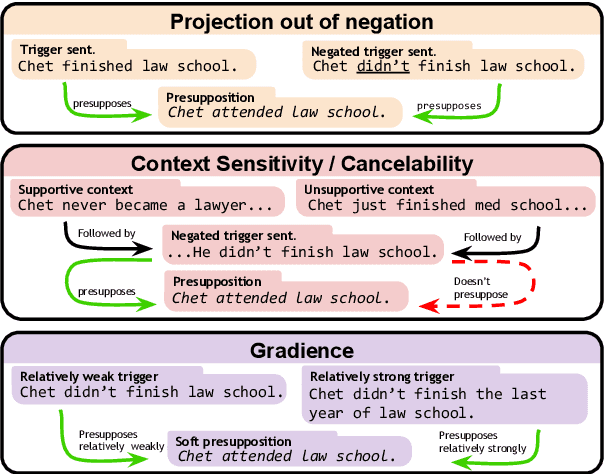
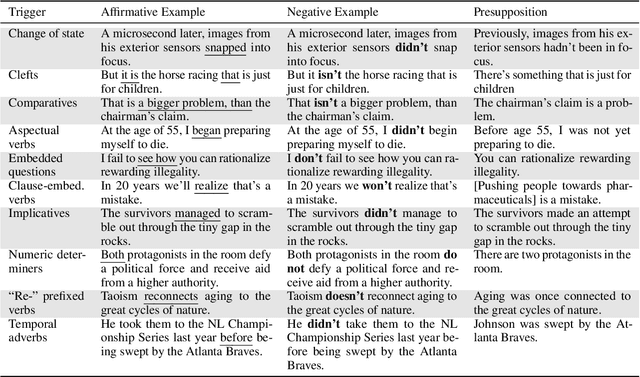
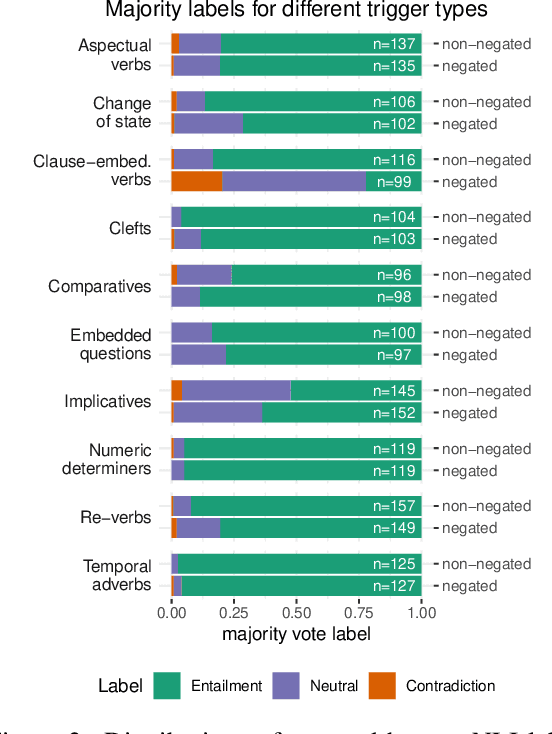

Abstract:Understanding language requires grasping not only the overtly stated content, but also making inferences about things that were left unsaid. These inferences include presuppositions, a phenomenon by which a listener learns about new information through reasoning about what a speaker takes as given. Presuppositions require complex understanding of the lexical and syntactic properties that trigger them as well as the broader conversational context. In this work, we introduce the Naturally-Occurring Presuppositions in English (NOPE) Corpus to investigate the context-sensitivity of 10 different types of presupposition triggers and to evaluate machine learning models' ability to predict human inferences. We find that most of the triggers we investigate exhibit moderate variability. We further find that transformer-based models draw correct inferences in simple cases involving presuppositions, but they fail to capture the minority of exceptional cases in which human judgments reveal complex interactions between context and triggers.
Universal Dependencies v2: An Evergrowing Multilingual Treebank Collection
Apr 22, 2020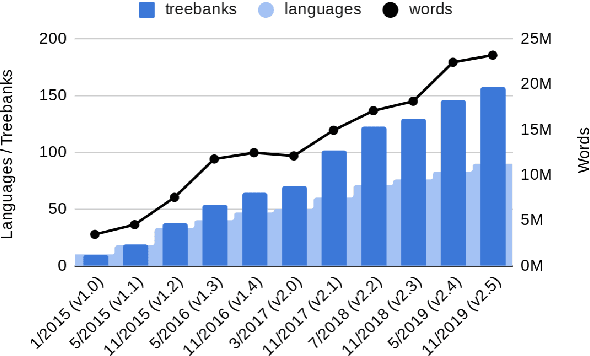
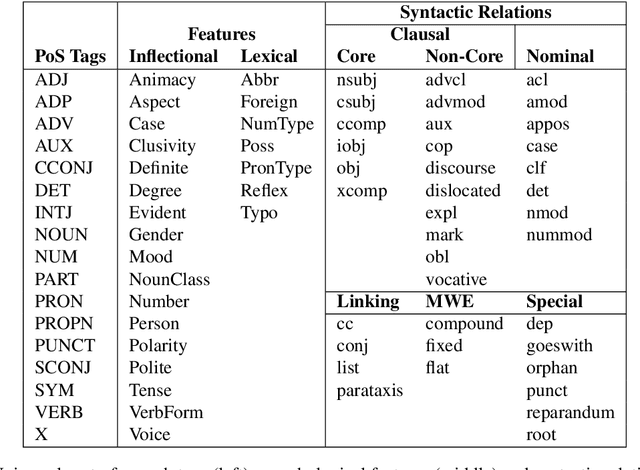


Abstract:Universal Dependencies is an open community effort to create cross-linguistically consistent treebank annotation for many languages within a dependency-based lexicalist framework. The annotation consists in a linguistically motivated word segmentation; a morphological layer comprising lemmas, universal part-of-speech tags, and standardized morphological features; and a syntactic layer focusing on syntactic relations between predicates, arguments and modifiers. In this paper, we describe version 2 of the guidelines (UD v2), discuss the major changes from UD v1 to UD v2, and give an overview of the currently available treebanks for 90 languages.
Harnessing the richness of the linguistic signal in predicting pragmatic inferences
Oct 31, 2019
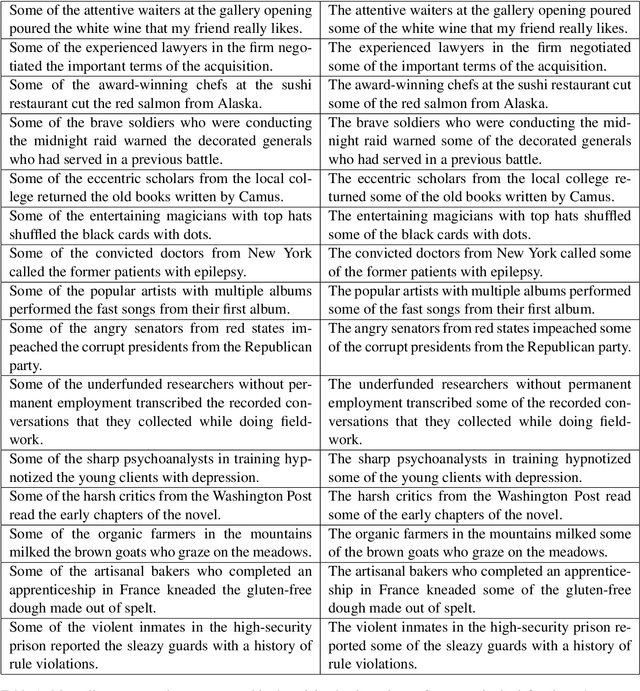
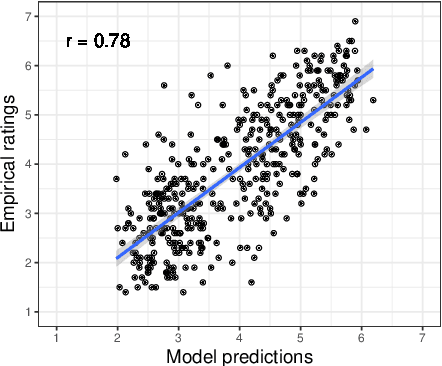

Abstract:The strength of pragmatic inferences systematically depends on linguistic and contextual cues. For example, the presence of a partitive construction increases the strength of a so-called scalar inference: humans perceive the inference that Chris did not eat all of the cookies to be stronger after hearing "Chris ate some of the cookies" than after hearing the same utterance without a partitive, "Chris ate some cookies". In this work, we explore to what extent it is possible to learn associations between linguistic cues and inference strength ratings without direct supervision. We show that an LSTM-based sentence encoder with an attention mechanism trained on a dataset of human inference strength ratings is able to predict ratings with high accuracy (r=0.78). We probe the model's behavior in multiple analyses using corpus data and manually constructed minimal pairs and find that the model learns associations between linguistic cues and scalar inferences, suggesting that these associations are inferable from statistical input.
 Add to Chrome
Add to Chrome Add to Firefox
Add to Firefox Add to Edge
Add to Edge